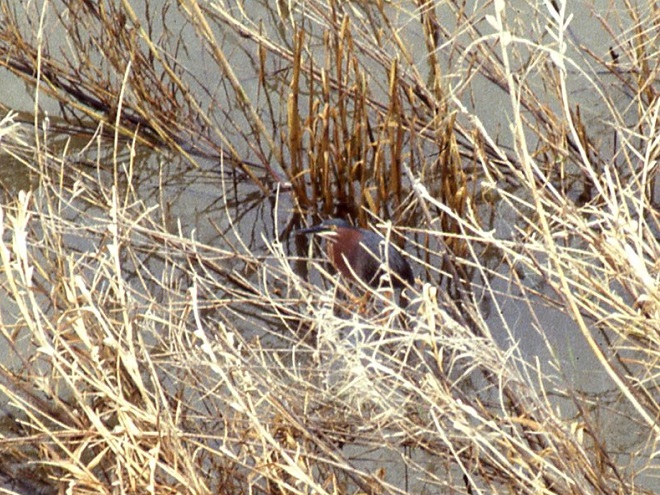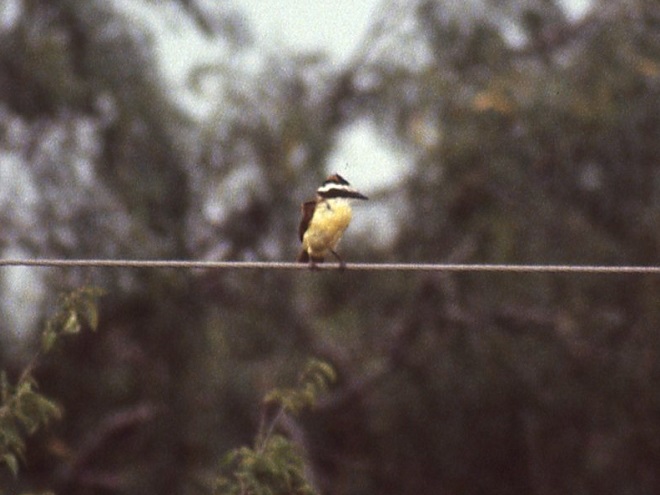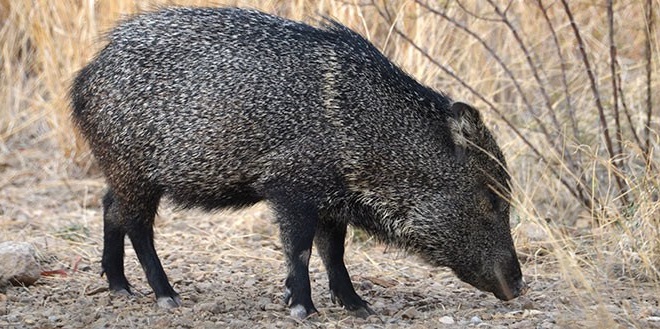Back in late May of 1983, four members of the Lancaster County Bird Club—Russ Markert, Harold Morrrin, Steve Santner, and your editor—embarked on an energetic trip to find, observe, and photograph birds in the Lower Rio Grande Valley of Texas. What follows is a daily account of that two-week-long expedition. Notes logged by Markert some four decades ago are quoted in italics. The images are scans of 35 mm color slide photographs taken along the way by your editor.
DAY TEN—May 30, 1983
“Falcon Dam State Park, Texas”
“9:30 — Breakfast — The Pauraque sang all nite and the Mockingbird sang half the nite and interrupted my sleep.”
Before leaving the campground, we paid a final visit to the shores of the reservoir. We saw Anhinga and Little Blue Heron among the other water birds we had seen there previously.
“Now to the spillway again. We got lucky — A Green Kingfisher flew in and gave us great views. Cliff Swallows were plentiful. The Green Herons were fishing and so was a Kiskadee Flycatcher. Black Vultures were flying around. A Groove-billed Ani was very much in evidence.”
The little Green Kingfisher (Chloroceryle americana), after all the effort we finally saw one. It was just half the size of the Ringed Kingfisher we saw at the spillway one day earlier.


“Here we met Bill Graber from San Antonio. Ron and 3 women—Sandra from Wales, 1 from Oregon, and 1 from San Antonio… We all walked to the spot for the Ferruginous Owl”
We again followed Father Tom’s directions; “Park at spillway, walk the road to a fence, go right to the river, follow fence to a big dip (gully).”
Once in the designated area, several of us began searching around the vicinity for the owls. I was out of sight of the others and was examining a long procession of tropical leafcutter ants, possibly the Texas Leafcutter Ant (Atta texana). Their foraging trail had two single-file lanes—worker ants carrying dime-sized pieces of leaves to the nest and worker ants returning to the tree to harvest more. The ants’ path of travel stretched for more than one hundred feet down the limbs and trunk of the source tree, across the sandy ground, over a fallen log, across more sandy ground, through some leaf litter in the shrubs, and to the nest, where the foliage will be used to cultivate fungi (Lepiotaceae) for food. Thousands of worker ants were marching the route while others guarded their lines—fascinating.
Suddenly, I heard a commotion in the brush. Collared Peccaries (Dicotyles tajacu), also known as Javelina, on the run and headed right my way! The others must have unknowingly spooked them. In an instant I scrambled to my feet and bounded up the trunk of a willow tree that was strongly arching toward the river and had partially fallen after the bank had washed away. There I stood atop the nearly horizontal trunk as between 6 and 10 grunting peccaries bustled past in a cloud of dust. Just as fast as they had appeared, they were gone.

I walked back toward the gully and as I approached, I could see everyone peering at something in the dense foliage of the trees overhanging the river.
“…eventually Sandra spotted one coming in. Another was also seen in a much better position. We all saw the 2 black spots on the back of his head when he turned his head 180°. It looked like another face.”
They had found the Ferruginous Pygmy Owls, right where Father Tom said they would be. But they weren’t easy to see. And they were tiny. Make a loose fist—that’s about the size of a Ferruginous Pygmy Owl. We had to take turns standing at favorable places where there was a less-obstructed view of each bird. I’m not certain that anyone was able to get photographs. The shade was too dark for my equipment to get a favorable exposure. Such had been the case for many of the birds we found in the riparian forest. This owl was a life list species for everyone in our group and for most of the others. Like the Green Kingfisher, the owls were just barely within the A.B.A. area, on limbs stretching out above the waters of the Rio Grande.
“Then we came back to the picnic ground and walked the river’s edge for a 1/4 mile — Nothing extra, except an Altamira Oriole.”
I again did a little wading in the Rio Grande to cool down after spending hours in the hot scrubland/forest.
“On the way back to Brownsville, we stopped at Santa Margarita again with no Brown Jay luck.”
Though we never did bump into the roving band of Brown Jays at Santa Margarita Ranch, they were there, and they’re a species that’s still there today.
“On to Brownsville for good sightings of the Clay-colored Robin at the radio station.”
We returned to the radio transmitter site at Coria and Los Ebanos in Brownsville for yet another attempt to find Clay-colored Robins/Thrushes. After again securing permission from Mr. Wilson to have a look around, we at last had success and found a pair of Clay-colored Thrushes moving about in the boughs of the shade-casting tress and shrubs. With some persistence, we all got binocular views of these earth-tone rarities from Mexico.
While in Brownsville, we thought it a good idea to dabble a bit in the experiences of local consumer culture, so we drove downtown. After finding a place to park the camper, we commenced to going for an international stroll over the bridge that crosses the Rio Grande into Matamoras, Tamaulipas, Mexico. It was our first legal incursion south of the border. (In recent days, we may have stepped back-and-forth over the line a couple of times while wading in the river below Falcon Dam.)
Once in Matamoros, we entered the bank. Steve wanted to get some Mexican currency and coins for his collection, so we stepped inside. It was a typical classical-style masonry building like most banks built early in the twentieth century were, but this one had very few accoutrements inside. There was a big vault, some cash drawers, maybe a desk and a chair, and that was it. The doors were left open to get a flow of dirty air in the place because there was no air conditioning. No loan department or Christmas Clubs here, just dollars for pesos.
Upon leaving the bank and heading into the town, we were solicited by the unlicensed curbside pharmacists selling herbs and other home remedies. Not for me, I had one thing in mind on this shopping trip.
We walked up the street to step inside some of the numerous tourist shops—stuff everywhere. The other men bought a few post cards. For a friend back home, I bought a key chain with a tiny pair of cowboy boots attached. Having heard that cowboy boots could be had for cheap south of the border, he had given me his size requirements and asked that I should get him a pair if the price was right. Well, the price wasn’t that great in the tourist town section of the city, so I got him the key chain instead.
After about an hour, we were headed back over the bridge into Brownsville. Along the pedestrian walkway, there was a United States Customs checkpoint one had to pass before entering the country. The customs officer asked the usual questions and after telling him we were only in Mexico for an hour, he queried, “Did you buy anything that you’re bringing back into the country.” Having an item to declare, I told him yes, I bought a pair of cowboy boots. He looked down at my rubber-toed canvas sneakers, then looked at Russ, Harold, and Steve, who obviously weren’t carrying or wearing boots, and he snapped, “Where are they?” I pulled the wax paper bag with the key chain inside from my pocket. He called me a smart ass and waved us on. We chuckled.
The only bird species seen during or short trek into Matamoros? House Sparrow.
In the forty years since our visit to the Rio Grande Valley, the rate of northbound human migration across the river, and particularly the amount of smuggling activity that uses the migration as a diversion to cover its operations, has surely taken the fun out of being on the border. Many of the places we visited are no longer open to the public, or access is restricted and subject to tightened security. Santa Margarita Ranch, for example, now allows guided tours only. Falcon Dam changed its security practices after one of a pair of opposing drug cartels escalated their mutual dispute by planting explosives there—threatening to blow it up to hamper crossings by its opponent’s smugglers in the fordable waters downstream.
Fortunately for today’s birder, many of the tropical specialties have inched their range north of the Rio Grande’s banks and can be found on accessible public and private lands outside the immediate tension zone. National Wildlife Refuges and Texas State Parks provide access to some of the best habitats. Places like the King Ranch even offer guided bird and wildlife tours on portions of their vast holdings where many border species including Ferruginous Pygmy Owl, Crested Caracara (Caracara plancus), Green Jay, Vermillion Flycatcher (Pyrocephalus obscurus), Northern Beardless-Tyrannulet (Camptostoma imberbe), and the tropical orioles are now found. So don’t let the state of dysfunction on the border stop you from visiting south Texas and its marvelous ecosystems. It’s still a birder’s paradise!
“We ate supper at Luby’s Cafeteria and headed north on Route 77 for the Tropical Parula.”
Harold was very pleased to have added Hook-billed Kite, Ferruginous Pygmy Owl, and Clay-colored Thrush to his A.B.A. life list, so he offered to buy dinner. After visiting a mail box to get a few postcards on their way, we ate at Luby’s Cafeteria in Brownsville, which was an interesting experience for that time period. Luby’s was a regional restaurant chain. You could get in line there and select anything you wanted, then pay for it by the item. Luby’s predated the all-you-can-eat salad bar and buffet craze that would sweep the restaurant industry in coming years. Under the circumstances, it was perfect for us. After not eating much all week due to the hot, humid conditions that accompanied the unusually rainy weather, our appetites begged satisfaction—but the heat hadn’t relented, so we didn’t want to overdo it. The staff at Luby’s didn’t blink an eye at us entering the restaurant wearing field clothes. It was the first climate-controlled space we had enjoyed all week—very refreshing. We really enjoyed the experience and it recharged us all.
Near Raymondville along Route 77, a set of electric wires strung on tall wooden poles paralleled the highway. These poles were hundreds of yards away from road, but seeing a raptor atop one, we stopped and got out the spotting scope. It was yet another south Texas specialty, a White-tailed Hawk (Buteo albicaudalus), a bird of grassland and brush. Its range north of Mexico is limited to an area of Texas from the Lower Rio Grande Valley north through the King Ranch to just beyond Kingsville. A short while later, we saw one or two more on our way through the King Ranch.
“Saw a flock of White-rumped Sandpipers when we stopped for gas.”
Lest one might think that traveling through parts of five south Texas counties to go from Falcon Dam back east through the Lower Rio Grande Valley to Brownsville and then north for a return stay at the A.O.K. campground is just another day of birding punctuated by some driving every now and again, consider the mileage racked up on the odometer today—259 miles. Even the counties are bigger in Texas.
We topped off the fuel tank at a service station near Sarita, Texas, and saw the White-rumped Sandpipers (Calidris fuscicollis) in a pool of rainwater among the scrubland at roadside.
“We stopped at the AOK Camp Ground 7 miles south of Kingsville and will return to get the parula at the first rest stop south of Sarita. Now 9:30 CDST.”
WHY WORRY ABOUT SPIDERS AND SNAKES?
Back at the old A.O.K. campground, this time with Harold and Steve, we decided to have a camp fire for the first time on the trip. We bought a bundle of wood at the camp office and soon had it crackling. I broke out the harmonica, but knowing no cowboy tunes, soon stashed it away. We had better things to do. Did we bake some beans in an iron kettle on the hot embers? No, we ate plenty at Luby’s. Did we toast marshmallows on sticks and make s’mores? Nope. Did we roast our weenies and warm our buns? No, not that either. We simply sat around recapping our trip while scratching our itchy ankles. Seems each of us was hosting chigger larvae and these parasites, upon maturing to nymphs and departing, left irritating wounds in our skin where they had been feeding—right in the hollow of our ankles.
Chiggers (Trombiculidae), like spiders and ticks, are arachnids. They thrive in humid environments as opposed to arid climes. Our best guess was that we had picked them up while hiking around in the subtropical riparian forests along the Rio Grande in the early days of the trip. My wounds eventually left little red pimples where each tiny larva had been feeding. They healed about a week after I got home. Due to the severity of his wounds, Steve cancelled a second week of his trip. On his own, he was going to continue west along the Rio Grande to the area of Big Bend National Park, but instead booked a flight home. Chigger larvae are stealthy little sneaks—we never had any clue they got us until they were gone. So why worry about spiders and snakes?
